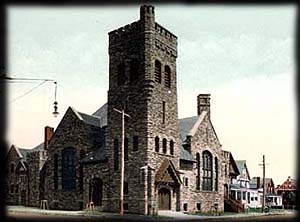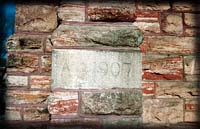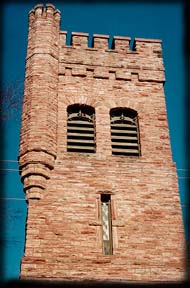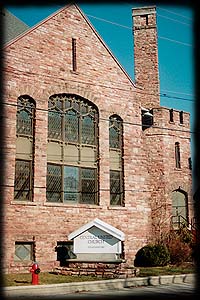|
|
These words were written in his journal by George M. McDougall on July 23, 1851, as he came to the end of his journey from Owen Sound to Sault Ste. Marie, to begin his missionary work among the Indians at Garden River. From there, Rev. McDougall and his successors looked after the growing Methodist community at Sault Ste. Marie. Reverend J. Caroll, DD., writing of McDougall in the Canadian Methodist magazine stated that
In addition to his work at Garden River McDougall had supervision of the Methodist work east to Bruce Mines and west to Sault Ste. Marie. In the winter of 1853, an account in his journal tells of one of his tours, "with my blanket, provisions, snowshoes and a faithful Ojibway for a companion I started out." P.S. Church, who had frequently assisted him with lumber, oxen and other favours said of McDougall,
The history of Central United Church would not be complete without acknowledgement of the tremendous contribution made by this pioneer missionary, whose convictions, courage, and perseverance laid the foundations for the first Methodist community in Sault Ste. Marie. In 1864 Reverend Samuel Down was sent to the district. While still residing at Garden River, he is the first Wesleyan Methodist minister listed for Sault Ste. Marie. The Methodist meetings in Sault Ste. Marie were held at what is presently known as the Ermatinger Old Stone House, then the residence of Sheriff W. H. Carney.Mr. Carney, who also used the house as a courthouse, used to take the service himself when no minister was present. In 1867 two ministers looked after the Methodist interests in this area, Reverend Down at Garden River and Reverend Samuel Fear at Sault Ste. Marie. The two missions were officially separated in 1871 when Garden River became an "Indian Mission" and Sault Ste. Marie a "Domestic Mission". Reverend Thomas Cleworth took over the congregation at Sault Ste. Marie, in 1872. A frame building had been erected on the northeast corner of Pim and Queen streets in 1870 to accomodate the growing congregation. In 1872 the first parsonage was erected on Church Street. The church was enlarged some twenty years later by an addition at the rear to accommodate the increasing Sunday School attendance. A steeple was also added. Even with the additions it was becoming obvious that the congregation was outgrowing the existing church building. In early 1897 the congregation purchased the present site of Central United Church at the corner of Spring and Albert streets for $700 and started making plans for building a new church. A building committee consisting of W. H. Hearst (who became premier of Ontario in 1914), Dr. Shannon, and Mr. Farwell was established in February of 1897. The committee was instructed to contact six of the "best architects" and ask them to submit plans for a church with a seating capacity of 450 on the ground floor. The building was also to include galleries.Total cost of the building was not to exceed $7500. By March 1897 the building committee was concentrating on the plans of Mr. Henry Simpson, an architect from Toronto. At the meeting of Trustees held March 23, 1897 the trustees referred the sketches back to the architect with a request that he alter the exterior to show a church more massive in appearance and of a style of architecture more "indicative of Methodism". The architect was also instructed to remove as many of the porches shown in his sketch as possible and to revise the seating arrangement in the manner suggested by the building committee. All action regarding the appointment of an architect was deferred until Mr. Simpson had an opportunity to resubmit his plans. Further alteration to the sketches were made by the Trustees in May of 1897, including the removal of yet another porch. The May meeting of Trustees also moved to defer building a new church at the present time. In July of that year the new plans by Mr. Simpson showing an above ground school room were accepted by the Trustees. At the November 25, 1897 meeting it was reported that Mr. Simpson would be willing to accept $75 as payment in full for the work done to date, and that he would complete the plans and specifications at a future date, as needed. The treasurer was instructed to pay Mr. Simpson as soon as funds permitted. It would seem the Methodist congregation was having financial problems. A subscription drive for a building fund was also started around this time. By July 1899 the Trustees were considering going ahead with building only a Sunday School Room at the new church site. However, it was not until December 1899 that the building committee was authorized to procure plans for a school room with a seating capacity of 450. At the same December meeting an offer by Mr. F.H. Clergue to purchase an additional plot of land 24 feet by 100 feet adjoining the church and to donate it to the church was accepted, provided Mr. Clergue supplied proof of title. A subscription fund for the school room was started early in 1900. The contract for building the school room was awarded to Isaac Taillifer in July 1900 for $6445. Building stone was obtained from the ship canal. Over 250 cords of stone were hauled by horse and wagon at $2.25 per cord. The building was completed in the same year and the corner stone layed in July 1900 by the Honourable William Mulock, K.C., Postmaster General of Canada. The building was dedicated by the pastor, Rev. S. G. Stone, on March 10, 1901. In November, 1900, arrangements were begun for selling the existing church on Pim and Wellington. An agreement to sell it to Mr. W.H. Plummer for $2200 was transferred to the Public School Board on March of 1901. Final arrangements for the sale were completed in July 1901. In March 1901 the parsonage on Church Street was also placed on sale for $1600. Mr. George Stone purchased it later that year for $1500. A committee was then established to arrange for plans for a new Parsonage. James Thomson, a Sault Ste. Marie architect was chosen.The parsonage was to be located on the plot of land previously donated by Mr. Clergue. However, it took two calls for tenders before the contract for the construction of the parsonage was awarded to Mr. A. C. McLeod on July 8, 1901. The new parsonage was ready for occupation in January 1902. Later that year the congregation received a donation of $5,000. from the estate of Mr. Hart A. Massey for the purpose of building a new church. This donation was on condition that the new church cost not less than $20,000 on which the congregation would contribute $5,000 at the start, and that the mortgage on the new building not exceed $10,000. A time limit for building the new church was also imposed as part of the conditions. On June 19, 1902 the building committee was authorized to secure sketches and estimates of probable costs for a church adequate to the needs of the congregation. A committee was also established to carry out a subscription fund for the new building. Preliminary sketches by Mr. H. Simpson of Toronto were chosen on December 10, 1902 from amongst three submissions, and Mr. Simpson was asked to complete the plans sufficiently enough to call for tenders. It is unclear whether these were new plans by Mr. Simpson, or were the plans sketched in 1897. Apparently Mr. James Thomson also submitted sketches, for at the December 17, 1902 meeting the Trustees thanked Mr. Thomson for his sketches, adding that while they did not accept them they appreciated his services just the same. In May 1903 the tenders were opened, the lowest one being for $29,150. The matter was then referred back to the architect since he had been instructed to prepare plans for a church costing $20,000. Reverend James Allen was also instructed to contact the executers of the Massey estate to see if the conditions of the donation could be altered so that a mortgage of more than $10,000 would be allowed, and that the time frame for building the church be extended. The Sault Star reported in February 1903 that the final plans called for a structure costing nearly $25,000 and having a seating capacity of 1000, which could be increased to 1500 by opening folding doors to the existing school room. On June 25, 1903 the Sault Star reported that Mr. Thomson was revising the plans and that fresh tenders would be called. On July 15, 1903 the contract for the church was given to Mr. George Hughes for $17,340. Mr. James Thomson was also retained as the local architect to supervise the work. The cornerstone was laid by Sheriff Carney on September 7,1903, but the collapse of the Consolidated Lake Superior Company and the subsequent depression interrupted the work the very next month. In December 1904 a new building fund to collect subscription for the church was re-started. Building operations were resumed in March of 1905. At this time the trustees decided that it was inadvisable to attempt more than the completion of the auditorium, leaving the building of the tower, vestries and parlour for a later time. The auditorium was completed and dedicated on February 18, 1906. The school room and auditorium being completed, the trustees in 1907 resolved to add the tower. The plans called for the tower to be 20 feet square and 70 feet high. It was to provide the main entrance to the church proper and to the gallery. Mr. A. C. McLeod was again awarded the contract for $5275. In 1910 McIntyre, Haining and Kelly were engaged to build a northeast addition to the Sunday School room containing the vestries, kitchen and meeting rooms. A basement room was also added at a later date again because of the need for space. In 1925 the church voted to join the union of the Methodist, Congregationalist and Presbyterian churches, and the Church was renamed Central United Church. ARCHITECTURAL DESIGN 
Massing: The main element or the church is the sanctuary, a grand, vaulted space completed in 1903. It is octagonal in plan, and positioned in the South-West corner of the site with Albert Street to the south and Spring Street to the west. A massive octagonal peaked roof covers the sanctuary.
East of Edwards Hall is a flat-roofed area which extends south to join the north east side of the sanctuary and terminates at the organ chamber immediately to the east of the sanctuary. Constructed in 1911, it was the last portion of the church to be built. Materials: The church is constructed primarily of roughly squared stone coursed in a rubble pattern. The indigenous red sandstone used is rock-faced; that is, the exposed face of the stone is left in the rough-hewn state in which it was quarried, thus producing a bold texture over the entire building. A matching red mortar is tuck-pointed on all joints except those on the flat-roofed portion to the north-east of the sanctuary, where the joints are flush. Copings are of salmon coloured cement as are the pitched capstones of pilasters.  
Window sills and banding are of sandstone. Diamond paned leaded glass is used in most of the windows and some of it is coloured. Almost all the windows have four-centred arches. The main roof over the sanctuary is covered by black asphalt shingles with wooden soffits and simply carved brackets. Spring Street Elevation (West) At the extreme left of the Spring Street (west) facade, the north-west corner of Edwards Hall is angled at forty-five degrees, a continuation of the octagonal geometry of the plan. Just to the right of the corner is a gabled wall with three long openings, the centre one being taller then the others. In each arched opening, there is a window at the top, a recessed spandrel of stone below, and window below that. To the right of this is a rectangular stairwell and secondary entrance which projects forward slightly. It has battlements, narrow slit-like windows and a shallow but steeply pitched gabled canopy constructed of wood over the entrance. This element marks the division between Edwards Hall to the left and the wall of the sanctuary to the right. The sanctuary is strongly articulated on the facade as a large gabled wall, compositionally providing a centre to the elevation; it is balanced by the massive bell tower to the left and several smaller elements to the right. The gabled sanctuary wall contains a large arched opening divided into three equal windows by vertical wooden mullions and divided horizontally by deep wooden spandrel panels. This opening is flanked on either side by slightly shorter windows, about one-third the width of the large opening, with similar horizontal spandrel panels. The upper windows in this set have simple wooden tracery near their tops. A long narrow vertical recess is centred in the otherwise unornamented gable. Next to this gabled wall, at the extreme right of the elevation and on the corner of Spring and Albert Streets, stands the bell tower. It is approximately four storeys in height with walls which step-back slightly as they rise. The short angle buttresses at the base of the tower have pitched capstones, and its walls are pierced by small arched windows, or, as in the belfry, the openings are louvred The belfry is capped by battlements and corbelled out from the corner of the belfry is a narrow turret, also with battlements. Albert Street Elevation (South) The south elevation of the bell tower facing Albert Street is almost identical to the west elevation; except for the main entrance to the sanctuary at its base. Six steps up from grade, the entrance is an arched, double width doorway, with a wooden canopy having a steeply pitched gable and scalloped fascia. The main doors are varnished oak with Gothic lights and long Gothic side-lights. The sanctuary is again articulated on the facade to the right of the bell tower, with a large gabled element similar in size and proportion to that on the west facade. The large central window flanked by two smaller windows is also repeated. The facade steps back to the right with the battlemented semi-octagonal stairwell adjoining the sanctuary. This element contains an arched doorway eleven steps above grade. Beyond this is a square chimney, and beyond this the facade ends well back from the street with the wall of the organ chamber. East And North Elevations
|



